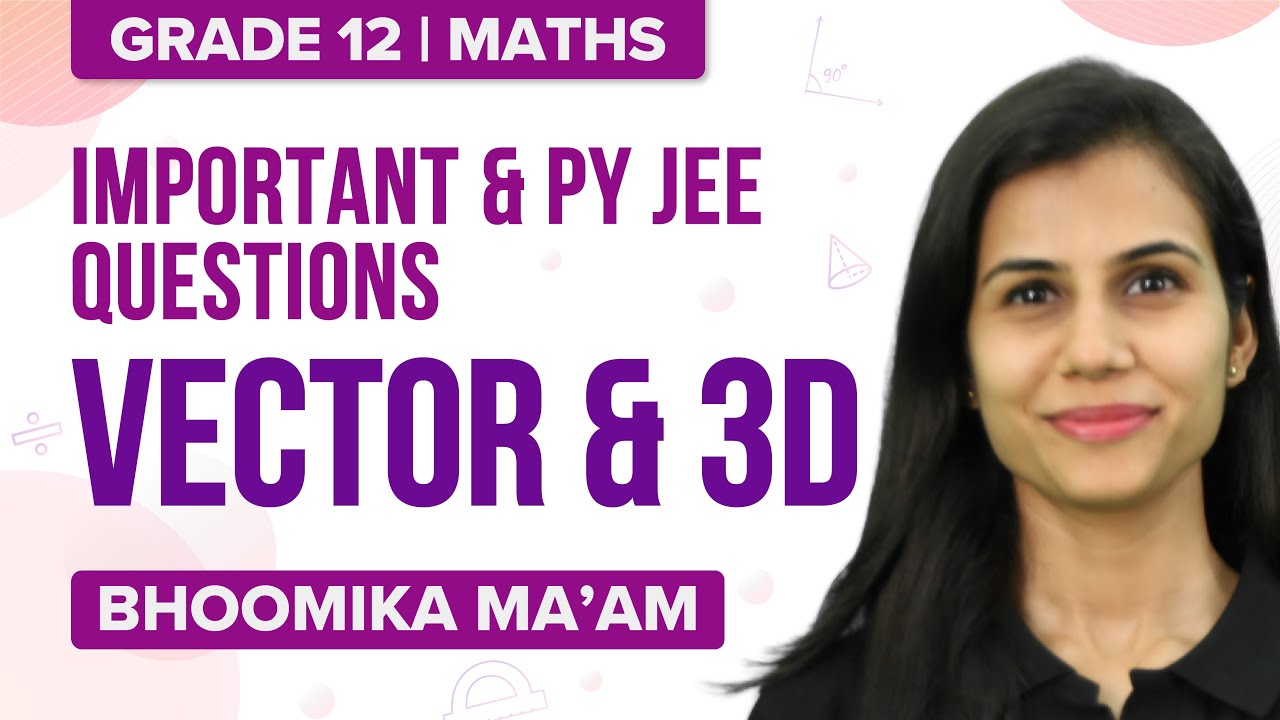Three-dimensional geometry JEE Advanced previous year questions with solutions are given on this page. Direction ratios and direction cosines of a line, the angle between two lines in terms of direction cosines and direction ratios, projection of a point on a line, the angle between two lines, the distance between two parallel lines, equation of a plane in different forms, etc. are the important topics in three-dimensional geometry. These solutions are prepared by our team of experts. Learning these solutions will definitely help you to easily crack the problems from three-dimensional geometry for the JEE Advanced exam.
Download Three Dimensional Geometry Previous Year Solved Questions PDF
Question 1: Perpendiculars are drawn from points on the line (x + 2)/2 = (y + 1)/-1 = z/3 to the plane x + y + z = 3. The feet of perpendiculars lie on the line is
(a) x/5 = (y – 1)/8 = (z – 2)/-13
(b) x/2 = (y – 1)/3 = (z – 2)/-5
(c) x/4 = (y – 1)/3 = (z – 2)/-7
(d) x/2 = (y – 1)/-7 = (z – 2)/5
Solution:
Given that the equation of the line is (x + 2)/2 = (y + 1)/-1 = z/3 = λ
So any point P on the line is x = 2λ-2, y = -λ-1, z = 3λ …(i)
It lies on the plane x + y + z = 3
⇒ (2λ – 2) + (-λ – 1) + 3λ = 3
⇒ 4λ – 6 = 0
⇒ λ = 3/2
Substitute λ in (i) and get P
So P = (1, -5/2, 9/2) …(ii)
We can observe that (-2, -1, 0) is a point on the line.
Let (x, y, z) be the foot of the perpendicular from point (-2, -1, 0) on the plane x + y + z = 3.
⇒ (x + 2)/1 = (y + 1)/1 = (z – 0)/1 = -[1(-2) + 1(-1) + 0(1) – 3]/(12 + 12 + 12)
⇒ Q(x, y, z) = (0, 1, 2) …(iii)
Direction ratios of PQ = (1, -7/2, 5/2) (from (ii) and (iii))
= (2, -7, 5) …(iv)
From (iii) and (iv), the equation of the required line is x/2 = (y-1)/-7 = (z-2)/5
Hence, option d is the answer.
Question 2: Two lines L1: x = 5, y/(3 – α) = z/-2 and L2: x = α, y/-1 = z/(2 – α) are coplanar. Then α can take values
(a) 1
(b) 2
(c) 3
(d) 4
Solution:
Given lines L1: x = 5, y/(3 – α) = z/-2 and
L2: x = α, y/-1 = z/(2 – α)
L1 and L2 are coplanar.
So
⇒ (5 – α)(3 – α)(2 – α) – 2 = 0
⇒ (5 – α)(6 – 3α – 2α + α2 – 2) = 0
⇒ (5 – α)(α – 1)(α – 4) = 0
⇒ α = 1, 4, 5
Hence, option a and d is the answer.
Question 3: Let P be the image of the point (3, 1, 7) with respect to the plane x – y + z = 3. Then the equation of the plane passing through P and containing the straight line x/1 = y/2 = z/1 is
(a) x + y – 3z = 0
(b) 3x + z = 0
(c) x – 4y + 7z = 0
(d) 2x – y = 0
Solution:
Equation of line passing through P is (x – 3)/1 = (y – 1)/-1 = (z – 7)/1
Distance of point P from the given plane = -2(6)/3 = -4
(x – 3)/1 = (y – 1)/-1 = (z – 7)/1 = -4
⇒ x = -1, y = 5, z = 3
⇒ P= (-1, 5, 3)
Equation of plane passing through P is a(x + 1) + b(y – 5) + c(z – 3) = 0
The normal of plane is perpendicular to the line from which this plane passes through.
So a + 2b + c = 0 ..(i)
The plane will also pass through the origin since the line passes through the origin.
So a – 5b – 3c = 0 ..(ii)
Solving (i) and (ii)
a/1 = b/-4 = c/7
Required equation of plane is (x + 1) -4(y – 5) +7(z – 3) = 0
⇒ x – 4y + 7z = 0
Hence, option c is the answer.
Question 4: The equation of the plane passing through the point (1, 1, 1) and perpendicular to the planes 2x + y – 2z = 5 and 3x – 6y – 2z = 7 is
(a) 14x + 2y + 15z = 31
(b) 14x + 2y – 15z = 1
(c) -14x + 2y + 15z = 3
(d) 14x – 2y + 15z = 27
Solution:
Let plane P1 ⇒ 2x + y – 2z = 5
P2 ⇒ 3x – 6y – 2z = 7
Let P be the plane perpendicular to P1 and P2
Also, P passes through (1, 1, 1).
Hence required equation is
⇒ (x – 1)(-2 – 12) – (y – 1)(-4 + 6) + (z – 1)(-12 – 3) = 0
⇒ 14x – 14 + 2y – 2 + 15z – 15 = 0
⇒ 14x + 2y +15z = 31
Hence, option a is the answer.
Question 5: If for some α ∈ R , the lines L1 : (x + 1)/2 = (y – 2)/-1 = (z – 1)/1 and L2 : (x + 2)/α = (y + 1)/(5 – α) = (z + 1)/1 are coplanar, then the line L2 passes through the point:
(a) (2, -10, -2)
(b) (10, -2, -2)
(c) (10, 2, 2)
(d) (-2, 10, 2)
Solution:
A(-1, 2, 1), B(-2, -1, -1)
-1(-1 + α – 5) + 3(2 – α) – 2(10 – 2α + α) = 0
6 – α + 6 – 3α + 2α – 20 = 0
-8 – 2α = 0
α = -4
L2: (x + 2)/-4 = (y + 1)/9 = (z + 1)/1
Check options. (2, -10, -2) satisfies the above equation.
Hence, option a is the answer.
Question 6: The distance of the point (1, -2, 3) from the plane x – y + z = 5 measured parallel to the line (x/2) = (y/3) = (z/-6) is:
(a) 1/7
(b) 7
(c) 7/5
(d) 1
Solution:
Equation of line through (1, -2, 3) whose d.r.s. are (2, 3, -6)
(x – 1)/2 = (y + 2)/3 = (z – 3)/-6 = λ
Any point on the line (2λ + 1, 3λ – 2, -6λ + 3)
Substitute in the equation of the plane.
x – y + z = 5
2λ + 1 – 3λ + 2 – 6λ + 3 = 5
-7λ = -1
λ = 1/7
Distance = √((2λ)2 + (3λ)2 + (6λ)2)
= √(4λ2 + 9λ2 + 36λ2)
= 7λ
= 1
Hence, option d is the answer.
Question 7: Let P be a point in the first octant, whose image Q in the plane x + y = 3 (that is, the line segment PQ is perpendicular to the plane x + y = 3, and the mid-point of PQ lies in the plane x + y = 3) lies on the z-axis. Let the distance of P from the x-axis be 5. If R is the image of P in the xy-plane, then the length of PR is
Solution:
Let the coordinates of P be (a, b, c).
Coordinates of Q are (0, 0, c), and the coordinates of R are (a, b, -c).
Given PQ is perpendicular to the plane x+y = 3
So PQ is parallel to the normal of the given plane.
(ai+bj) is parallel to (i+j). (i, j are unit vectors)
Comparing, we get a = b.
Since the midpoint of PQ lies on plane x+y = 3
So a/2 + b/2 = 3
⇒ a+b = 6
⇒ a = 3, b = 3
So distance of P from x-axis = √(b2 + c2) = 5 (given)
⇒ (b2 + c2) = 25
c2 = 25 – 9 = 16
⇒ c = ±4
So PR = |2c|
= 8
Question 8: Let α, β, γ, δ be real numbers such that α2 + β2 + γ 2 ≠ 0 and α + γ = 1. Suppose the point (3, 2, -1) is the mirror image of the point (1, 0, -1) with respect to the plane αx + βy + γz = δ. Then which of the following statements is/are TRUE?
(a) α + β = 2
(b) δ – γ = 3
(c) δ + β = 4
(d) α + β + γ = δ
Solution:

Midpoint of PQ = A(2, 1, -1)
Direction ratios of PQ = 2, 2, 0
As PQ is perpendicular to the plane and the midpoint lies on the plane.
The equation of the plane is
2(x – 2) + 2(y – 1) + 0(z + 1) = 0
⇒ x + y = 3
Comparing with αx + βy + γz = δ
We get α = 1, β = 1, γ = 0 and δ = 3
Hence options a, b, c are true.
Question 9: In R3, consider the planes P1: y = 0 and P2: x + z = 1. Let P3 be a plane, different from P1 and P2, which passes through the intersection of P1 and P2. If the distance of the point (0, 1, 0) from P3 is 1 and the distance of a point ( α, β, γ ) from P3 is 2, then which of the following relation is (are) true?
(a) 2α + β + 2γ + 2= 0
(b) 2α – β + 2γ + 4 = 0
(c) 2α + β – 2γ – 10= 0
(d) 2α – β + 2γ – 8 = 0
Solution:
Let P3 be P2 + λP1 = 0
⇒ (x + z – 1) + λy = 0
⇒ x + λy + z – 1 = 0
Distance of the point (0, 1, 0) from P3 is |(λ – 1)/√(2 + λ2)| = 1
⇒ (λ – 1)2 = (2 + λ2)
⇒ -2λ + 1 = 2
⇒ -2λ = 1
⇒ λ = -1/2
Distance of point (α, β, γ) from P3: |(α + λβ + γ – 1) /√(2 + λ2)| = 2
|(α-(β/2) + γ – 1) /(3/2)| = ±2
α- (β/2) + γ – 1 =± 3
⇒ 2α- β + 2γ – 2 =± 6
⇒ 2α- β + 2γ-8 = 0 or 2α- β + 2γ + 4 = 0
Hence option b and d are the answers.
Question 10: If the straight lines (x – 1)/2 = (y + 1)/k = z/2 and (x + 1)/5 = (y + 1)/2 = z/k are coplanar, then the plane(s) containing these two lines is (are)
(a) y + 2z = -1
(b) y + z = -1
(c) y – z = -1
(d) y – 2z = -1
Solution:
Given that lines are coplanar.
⇒ k = ±2
For k = 2, the equation of the plane is given by
⇒ y – z + 1 = 0
⇒ y – z = -1
For k = -2, the equation of the plane is given by
⇒ y + z + 1 = 0
⇒ y + z = -1
Hence, options b and c are correct.
Recommended Videos
Vectors and 3D – JEE Advanced PY Questions

Important JEE Questions – Vectors and 3D

Important JEE Topics – Vectors and 3D

Also Read
JEE Main Maths Three Dimensional Geometry Previous Year Questions With Solutions
Comments